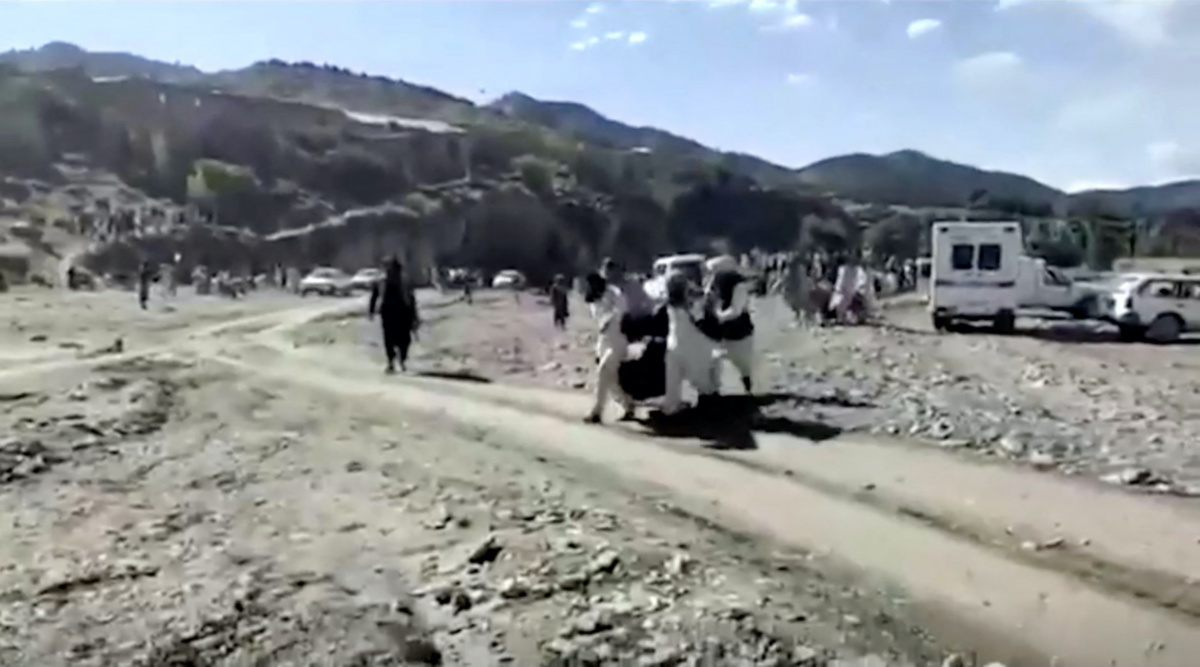Gayan, Afghanistan
Reuters
Aid began arriving on Thursday in a remote part of Afghanistan where an earthquake killed 1,000 people, with Taliban officials saying the rescue operation was almost complete.
The magnitude 6.1 earthquake struck early on Wednesday about 160 kilometres south-east of Kabul, in arid mountains dotted with small settlements near the border with Pakistan.

People carry injured to be evacuated following a massive earthquake, in Paktika Province, Afghanistan, on 22nd June in this screen grab taken from a video. PICTURE: Bakhtar News Agency/Handout via Reuters.
Poor communications and a lack of proper roads are hampering relief efforts in a country already grappling with a humanitarian crisis which has deteriorated since the Taliban took over last August.
“The rescue operation has finished, no one is trapped under [the] rubble,” Mohammad Ismail Muawiyah, a spokesman for the top Taliban military commander in the hardest-hit Paktika province, told Reuters.
Mohammad Nassim Haqqani, a spokesperson for the disaster ministry, told Reuters rescue operations had finished in major districts but were continuing in some isolated areas.
The United Nations said on Thursday the Taliban ministry of defence had indicated as early as Wednesday 90 per cent of search and rescue operations had been completed.
Two retired officers in Nepal involved in the aftermath of the 2015 quake that killed 9,000 people expressed surprise that the rescue operation could be close to completion so soon, but one noted that if most damaged homes were small, it was possible.
The earthquake killed about 1,000 people and injured 1,500, Muawiyah said. More than 3,000 houses were destroyed.
The death toll makes it Afghanistan’s deadliest earthquake in two decades, according to US Government data.
About 1,000 people had been rescued by Thursday morning, Sharafat Zaman, a spokesperson for the health ministry told Reuters.
“Aid has arrived to the area and it is continuing but more is needed,” he said.
The town of Gayan, close to the epicentre, sustained significant damage with most of its mud-walled buildings damaged or completely collapsed, a Reuters team said.
The town, with only the most basic roads, was bustling with Taliban soldiers and ambulances as a helicopter bringing in relief supplies landed nearby, whipping up huge swirls of dust. About 300 people sat on the ground waiting for supplies.
“Unprecedented crisis”
The rescue operation will be a major test for the hardline Islamist Taliban, who took over as US-led international forces withdrew after two decades of war.
The humanitarian situation has deteriorated alarmingly since the Taliban takeover, aid officials say, with the country cut off from much international assistance because of sanctions.
Abdul Qahar Balkhi, spokesperson for the Afghan foreign ministry, on Thursday repeated calls for international aid.
“We call on natural disaster management agencies and the international community to provide immediate and comprehensive aid to the Afghan people,” he said in a tweet.
We rely on our readers to fund Sight's work - become a financial supporter today!
For more information, head to our Subscriber's page.
Afghanistan’s economy has all but collapsed, UN Secretary-General Antonio Guterres said in an appeal to aid donors in late March.
Drought has undermined food production and nine million Afghans face famine. Some families have been forced to selling children and organs to survive, he said.
The United Nations said its World Food Programme was sending food and logistics equipment to affected areas, with the aim of initially supporting 3,000 households.
“The Afghan people are already facing an unprecedented crisis following decades of conflict, severe drought and an economic downturn,” said Gordon Craig, WFP deputy country director in Afghanistan.
“The earthquake will only add to the already massive humanitarian needs they endure daily.”
Japan, South Korea, Taiwan and the United Arab Emirates all said on Thursday they plan to send aid. Supplies from neighbour Pakistan have already crossed the border.
Large parts of South Asia are seismically active because a tectonic plate known as the Indian plate is pushing north into the Eurasian plate.
In 2015, an earthquake struck the remote Afghan north-east, killing several hundred people in Afghanistan and nearby northern Pakistan.
– Additional reporting by EMMA FARGE in Geneva, Switzerland.





